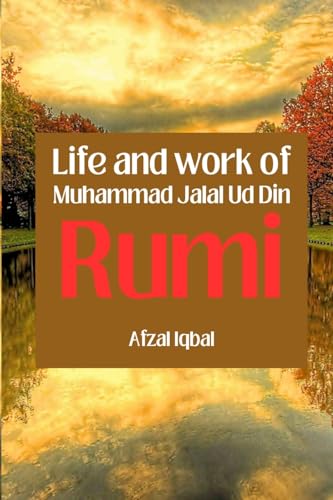Life and work of Maulana Jalal Ud Din Rumi
Afzal Iqbal
Paperback, 330 Pages, Black & White
6 x 9 Inches
Qadeem Press
Rumi is perhaps the only example in world literature of a devoted prose writer who suddenly burst forth into poetry during middle age to become a truly great mystical poet for all time. This book, a long-overdue reckoning of his life and work, begins with a description and examination of the living conditions in 13th-century Persia.
Building on this context, Afzal Iqbal proceeds to fully analyse the formative period of Rumi’s life leading up to 1261―when he began the monumental work of writing the Mathnawi. Toward the end of the book, Iqbal more generally investigates Rumi’s thought and includes translations of those portions of the Mathnawi that have been hitherto unavailable in English.
Combining an unparalleled familiarity with the source material, a total and critical understanding of the subject, and a powerful and readable prose style, this is an extraordinary study of a truly remarkable poet and mystic.
Table of Contents:
1. The Age of Rumi (A.D. 1207-1273)
The tottering fabric of Muslim society
The onslaught from Christian Europe
The Crusaders-their hopes and fears
Some contradictions analysed
A glimpse of the Christian mind in the thirteenth century
Shifting from Europe to Asia
Meeting the challenge of the Mongols
The sack of Baghdad (1258)
Defeat of the Mongols in Egypt (1260)
The origin and character of the Mongols
The social and economic conditions of Persia under the Mongols
A parallel between the roles of Ghazali and Rumi
Shifting to Konya-the centre of Rumi’s activities
The rise of Saljuqs and the importance of Konya
2. The Period of Preparation (A.D. 1207-1244)
The story of his ancestors
The role of Baha-ud-Din, Rumi’s father
Life and Work of Rumi
His hostility towards philosophy and conflict with Fakhr-ud-Din Razi
Was Razi responsible for his exile from Balkh? The confusion about the dates of migration clarified
A royal invitation to settle in Konya
Rumi’s education under his father-contemporary syllabus of studies analysed
The end of one phase of education at the death of Rumi’s father and the beginning of another
An analysis of the intellectual horizon of Rumi at the age of thirty-four
Debt to Ghazali-a brief comparison
Debt to Sana’i and ‘Attar-Rumi sees himself as a successor to both
Rumi’s knowledge of Classical Islamic philosophy
Rumi heir to an impressive heritage of Sufism
Dhu’l-Nun al-Misri, hero of a story in the Mathnavi
Respect and admiration for Bayazid Bistami
Mathnavi replete with references to Ibrahim ibn Adham
Rumi’s defence of Mansur Hallaj
Classical Manuals of Sufism in the tenth century
Kashf-ul-Mahjub quoted copiously in the Mathnavi
A brief comparison and contrast with Ibn ‘Arabi’s thought
3. The Romance of Revolution (A.1. 1244-1250)
An account of Shams-i-Tabriz
Four different versions of Rumi’s meeting with Shams
The version Rumi’s son
The result of the resting
Rumi’s correspondence in verse with Shams
Reasons of Shams’s unpopularity with Rumi’s followers
Rumi’s new mode of life
The role of Salah-ud-Din Zarkob in this period
Rumi fails to find Shams but discovers himself
4. The Miracle of the Muse (A.D. 1245-1260)
Rumi becomes a poet at the age of thirty-seven Consideration of his collection of odes called Divan-i. Shams-i- Tabriz
A critical estimate of his lyrics
Characteristics of his lyrics
His universal appeal
5. The Message of the Mathnavi (A.D. 1261-1273)
A general summary
Nature of existence
Nature of knowledge
Free-will and determinism
Nature of Love
Nature of Reality
6. The Poet as a Thinker (A.D. 1261-1273)
The difference between his method and the method of philosophers
The relation between Love and intellect
The nature or the self
His conception of evolution
Some difficulties in this conception
Determinism and responsibility
Knowledge of God
The ideal Man





